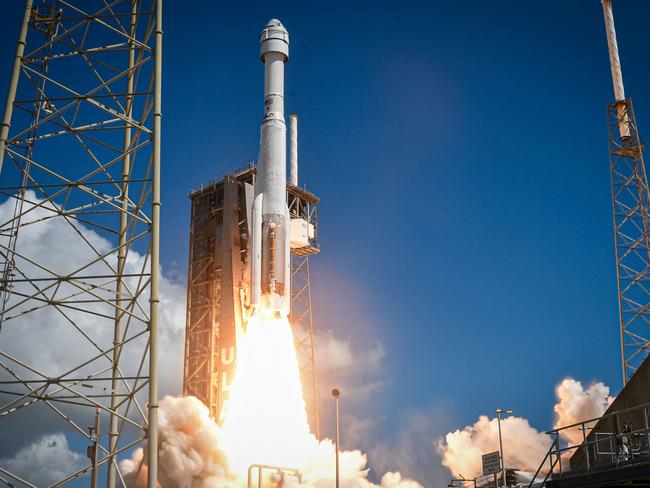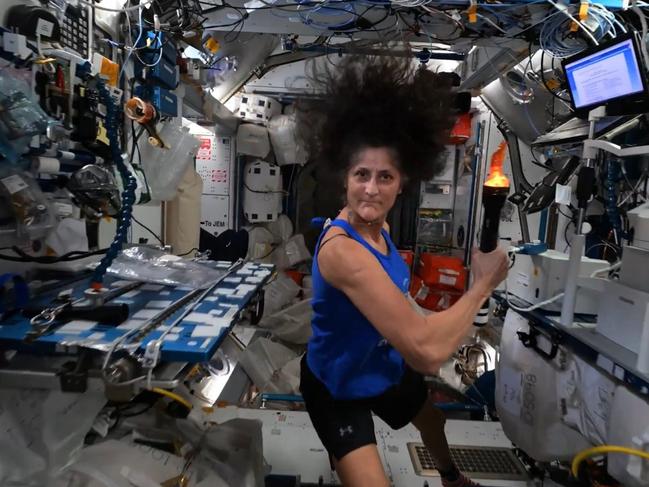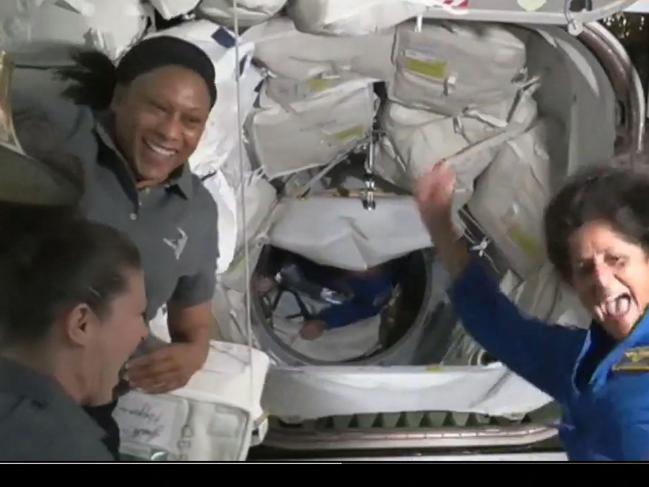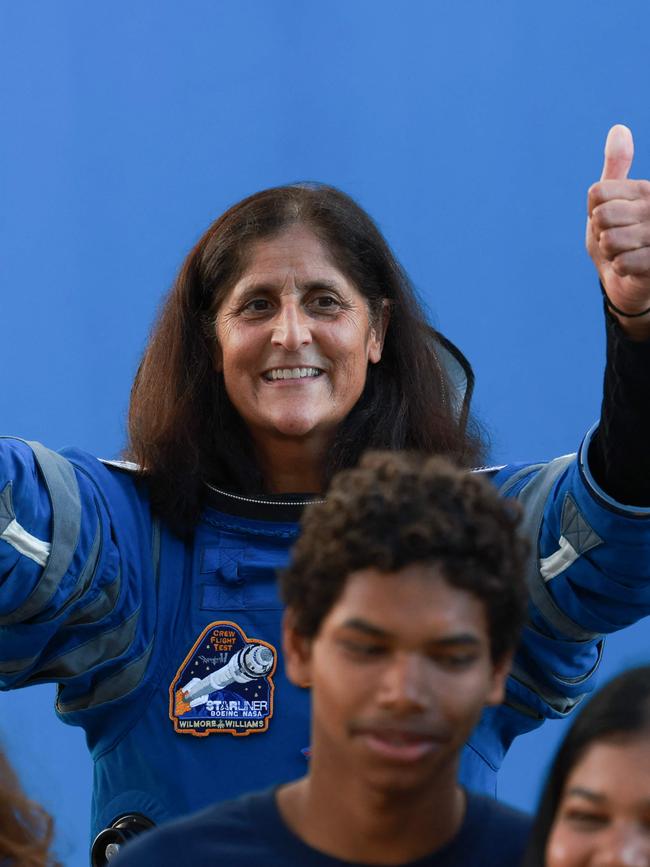NASA weighs SpaceX rescue for stranded Boeing Starliner cre
There’s more bad news for astronauts Butch Wilmore and Suni Williams who have been stuck on the International Space Station for two months.

Space
Don't miss out on the headlines from Space. Followed categories will be added to My News.
What was meant to be a weeklong trip to the International Space Station (ISS) for the first NASA astronauts to fly with Boeing could extend to eight months, with the agency considering bringing them home on a SpaceX spaceship.
A final decision on whether to persist with Boeing’s troubled Starliner - which experienced worrying propulsion issues as it flew up to the orbital platform in June - is expected later this month, officials said on Thursday AEST in a call with reporters.
Detailed planning is already underway with Boeing’s rival SpaceX, owned by Elon Musk, to potentially launch their scheduled Crew-9 mission on September 24 with just two astronauts rather than the usual four.
The Crew Dragon capsule would then be able to return to Earth with Starliner’s crew of Butch Wilmore and Suni Williams in February 2025 - in what would amount to a major embarrassment for aerospace giant Boeing.

In this scenario, Starliner would fly back without crew before Crew-9 launches.
Steve Stich, program manager for NASA’s Commercial Crew Program, revealed that there had been intense discussions on the best way forward, with Boeing expressing confidence in its spacecraft after carrying out ground testing to replicate the technical issues seen in space.
“I think the NASA community in general would like to understand a little bit more of the root cause and the physics,” he said.
Notably absent from the briefing were representatives from Boeing, heightening the perception of a rift.
On August 2, the company released a blog update stating it “remains confident in the Starliner spacecraft and its ability to return safely with crew.”
DESIGN FLAWS
NASA and Boeing have been conducting tests at the White Sands Testing Facility in New Mexico to better understand why some of Starliner’s thrusters experienced a loss of power as it approached the ISS, and why it sprung several leaks of helium, used to pressurise the propulsion system.
Stich said the latest analysis of why the thrusters failed pointed to the flow of fuel being choked within a “poppet” valve, as well as overheating causing some fuel to vaporise.
Officials previously said the helium leaks might be due to the use of undersized seals.
NASA’s Ken Bowersox, associate administrator for NASA’s Space Operations Mission Directorate, insisted that returning with Starliner remained the “prime option.”

However, if Wilmore and Williams return with SpaceX, it would mark the biggest setback to date for Boeing’s space program, as the century-old company continues to reel from the safety crisis affecting its commercial jets.
Both Boeing and SpaceX were awarded multibillion-dollar contracts in 2014 to provide the US space agency with rides to the ISS following the end of the space shuttle program in 2011, which left the United States reliant on Russian Soyuz rockets to ferry its crew.
SpaceX succeeded in its first crewed test in 2020 and has carried dozens of people since.
Boeing’s program, by contrast, has faced numerous delays amid setbacks ranging from a software bug that put the spaceship on a bad trajectory on its first uncrewed test, to the discovery that the cabin was filled with flammable electrical tape after the second.
The crewed test itself experienced two aborted launch attempts that came as the astronauts were strapped in and ready for liftoff.
STRANDED ASTRONAUTS’ HILARIOUS VIDEO
Being stuck in outer space might sound like the plot of a bad sci-fi movie but the astronauts stranded on-board the International Space Station (ISS) appear to be having the time of their lives.
Marooned test pilots Butch Wilmore and Suni Williams made a hilarious video of their own “Space Olympics” complete with a torch relay in honour of the Paris Games.


Wilmore tried his hand at shot put sending his throw merrily spiralling through the space station.
Meanwhile Williams performed an impressive gymnastics routine aided by the lack of gravity.
NASA released the lighthearted clip on X, formerly known as Twitter, along with a message from the astronauts to the athletes.
“Over the past few days on the ISS we’ve had an absolute blast pretending to be Olympic athletes,” the message reads.
“We, of course, have had the benefits of weightlessness.
“We can’t imagine how hard this must be to be such a world-class athlete doing your sports under actual gravity.
Let the games begin!
— NASA (@NASA) July 26, 2024
Athletes from across the world are gathering today to kick off the 2024 #Olympics – pushing boundaries and inspiring generations. If you were an Olympic athlete, which sport would you play? pic.twitter.com/mnFC3vpvly
“So from all of us aboard the ISS to every single athlete in the Olympic Games, God speed.”
The crew also shared a dazzling snap of the view of Paris from space lit up in a flurry of Olympic energy.
WHAT HAPPENED WITH STARLINER?
The spacecraft blasted off from Florida atop a United Launch Alliance Atlas V rocket on June 5.
Then, NASA and Boeing decided to postpone the spacecraft’s return after it docked on the International Space Station on June 6.
Revelations of thruster malfunctions and helium leaks have since delayed its return, with an initial date set for July 26.
It was known there was one helium leak affecting Starliner before the launch. However, other leaks emerged during the flight.
“NASA and Boeing leadership are adjusting the return to Earth of the Starliner Crew Flight Test spacecraft,” NASA said.
“The move off Wednesday, June 26, deconflicts Starliner’s undocking and landing from a series of planned International Space Station spacewalks while allowing mission teams time to review propulsion system data.”

HOW ARE THE ASTRONAUTS COPING?
The astronauts are in no danger, according to NASA.
“I feel confident that if we had to, if there was a problem with the international space system, that we can get into our space craft, undock, talk to our team and figure out the best way to come home,” Williams said in an update last month.
“We’ve practised a lot. I have a real good feeling in our heart that this spacecraft will bring us home, no problem.”
Stich said the focus remains to return Williams and Wilmore home.
“I think we’re starting to close in on those final pieces of the fight rationale to make sure we can come home safely and that’s our primary focus right now,” he said.
The international space station has plenty of supplies, enough to last until at least mid-August, according to NASA.
WHY DID THEY GO INTO SPACE?
Williams and Wilmore are part of crucial scientific research.
According to NASA, the astronauts are “exploring ways to effectively water plants in the weightless environment.”
Williams and Wilmore have been testing various methods to manage plant growth in microgravity.
“The duo took turns throughout the day in the Harmony module testing how root models and plants of various sizes would absorb water in microgravity,” NASA said.
Their research includes techniques like hydroponics and air circulation to nourish plants growing aboard spacecraft.


WHAT IS IT LIKE LIVING ON A SPACESHIP?
Astronauts keep very busy with a strict daily routine of experiments, planning, meals and exercise aboard a spaceship, according to NASA.
A typical day starts with breakfast, personal hygiene, housecleaning and checking the daily
schedule on a laptop computer.
Next, blood samples are drawn for analysis later in the day followed by a daily conference with Mission Control.
Routine air quality checks are conducted, with the crew then hitting the treadmill and exercise bike for a two-hour daily
exercise regimen.
After lunch, the crew receives a one-hour break and then it’s back to work, doing routine maintenance on the
station, conducting research and working on experiments, NASA said.
More checks follow such as cabin air pressure, and then more exercise.
WHY IS EXERCISE IN OUTER SPACE SO IMPORTANT?
Without Earth’s gravity, bone and muscle mass can become smaller and weaker, according to NASA.
Scientists realised exercise is a critical part of maintaining healthy bones and muscles in space, just as it is on Earth.
From simple elastic bands on early missions, exercise hardware has become increasingly advanced, NASA said.

WHAT IS NEEDED FOR THE ASTRONAUTS TO RETURN
NASA said it needs to conduct additional testing and evaluation of the helium leak and thruster issues before Williams and Wilmore can return to Earth.
Space agency engineers suspected faulty seals may be behind the helium leaks, which they thought pose little risk. But the thruster issues have caused the delays.
A test thruster on Earth at a testing facility will be put through simulated launches, dockings and landing burns.
“Once that testing is done, then we’ll look at the plan for landing,” Stich said.
More Coverage
Originally published as NASA weighs SpaceX rescue for stranded Boeing Starliner cre




